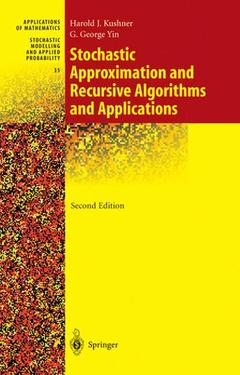Description
Stochastic Approximation and Recursive Algorithms and Applications (2nd Ed., 2nd ed. 2003)
Stochastic Modelling and Applied Probability Series, Vol. 35
Authors: Kushner Harold, Yin G. George
Language: English
Subjects for Stochastic Approximation and Recursive Algorithms and...:
Stochastic Approximation and Recursive Algorithms and Applications (2nd Ed.)
Publication date: 11-2010
478 p. · 15.5x23.5 cm · Paperback
Publication date: 11-2010
478 p. · 15.5x23.5 cm · Paperback
210.99 €
Subject to availability at the publisher.
Add to cart
Stochastic approximation & recursive algorithms & applications, (Applications of mathematics, Vol. 35), (2nd Ed.) POD
Publication date: 07-2003
Support: Print on demand
Publication date: 07-2003
Support: Print on demand
Description
/li>Contents
/li>Comment
/li>
The basic stochastic approximation algorithms introduced by Robbins and MonroandbyKieferandWolfowitzintheearly1950shavebeenthesubject of an enormous literature, both theoretical and applied. This is due to the large number of applications and the interesting theoretical issues in the analysis of ?dynamically de?ned? stochastic processes. The basic paradigm is a stochastic di?erence equation such as ? = ? + Y , where ? takes n+1 n n n n its values in some Euclidean space, Y is a random variable, and the ?step n size? > 0 is small and might go to zero as n??. In its simplest form, n ? is a parameter of a system, and the random vector Y is a function of n ?noise-corrupted? observations taken on the system when the parameter is set to ? . One recursively adjusts the parameter so that some goal is met n asymptotically. Thisbookisconcernedwiththequalitativeandasymptotic properties of such recursive algorithms in the diverse forms in which they arise in applications. There are analogous continuous time algorithms, but the conditions and proofs are generally very close to those for the discrete time case. The original work was motivated by the problem of ?nding a root of a continuous function g ¯(?), where the function is not known but the - perimenter is able to take ?noisy? measurements at any desired value of ?. Recursive methods for root ?nding are common in classical numerical analysis, and it is reasonable to expect that appropriate stochastic analogs would also perform well.
Introduction: Applications and Issues.- Applications to Learning, Repeated Games, State Dependent Noise, and Queue Optimization.- Applications in Signal Processing, Communications, and Adaptive Control.- Mathematical Background.- Convergence with Probability One: Martingale Difference Noise.- Convergence with Probability One: Correlated Noise.- Weak Convergence: Introduction.- Weak Convergence Methods for General Algorithms.- Applications: Proofs of Convergence.- Rate of Convergence.- Averaging of the Iterates.- Distributed/Decentralized and Asynchronous Algorithms.
Includes supplementary material: sn.pub/extras
© 2024 LAVOISIER S.A.S.




